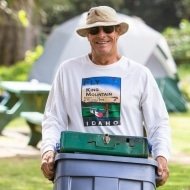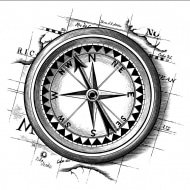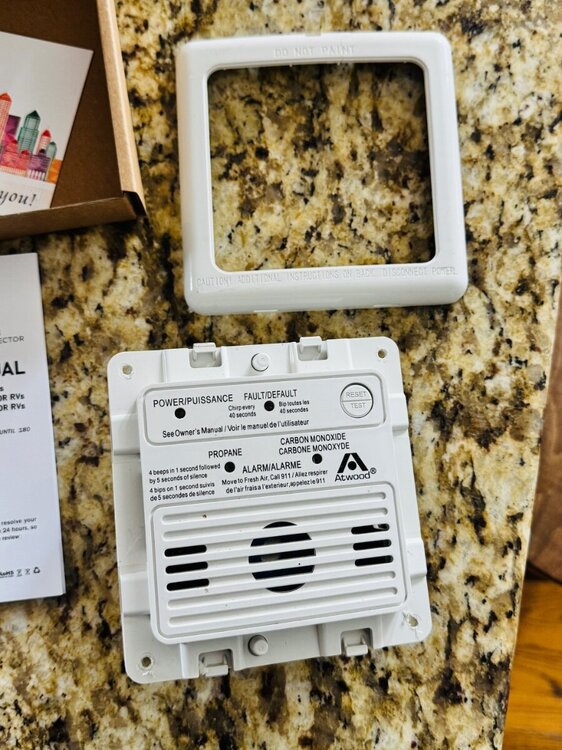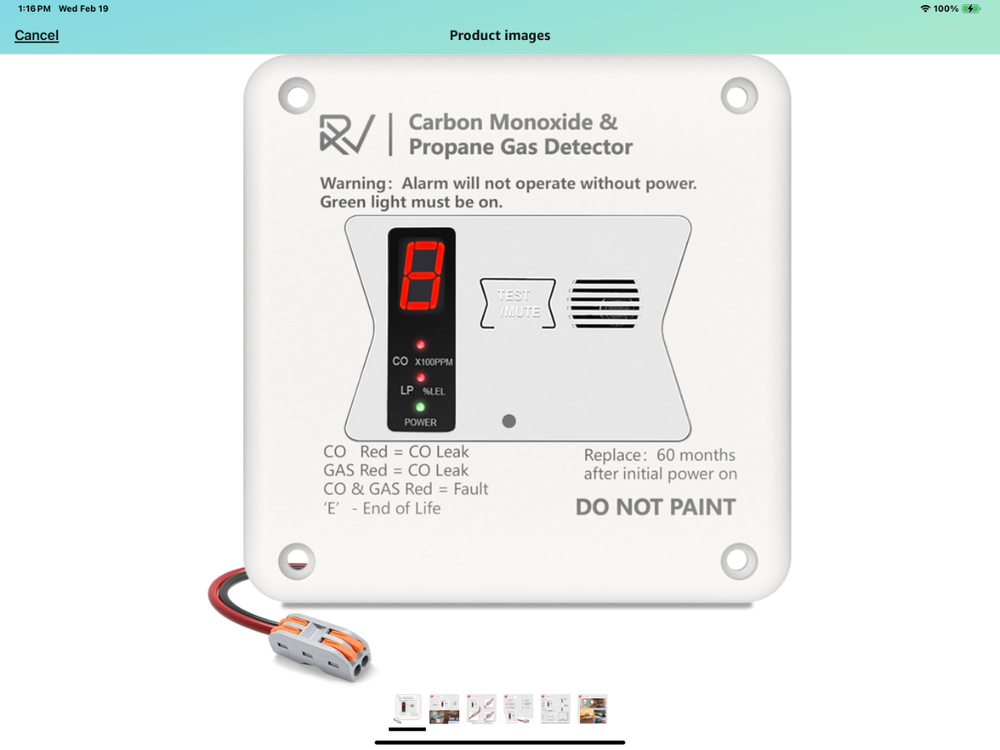Leaderboard
Popular Content
Showing content with the highest reputation on 02/26/2025 in all areas
-
Last week during some unusually cold south Texas weather we ran both of our 30 lb tanks to completely empty. We took them to a nearby U-Haul for refill while the temperatures were still in the low 20's. We were charged for volume (16.9 gallons), not weight of propane. After getting them home, as the weather warmed, we noticed a faint smell of the gas odorant. We found that the pressure relief valves were bleeding off propane. We had a serious fire hazard. A little online research suggested that based on volume, tanks are sometimes overfilled in cold weather. Liquid propane is denser at low temperatures, so more (by weight) can be filled in colder temperatures before the Overfill Protection Device (OPD) shuts off the flow. There are also recommendations for the entire valve to be replaced whenever the pressure relief has popped. We took the tanks to Propane Depot, a specialty supplier. They weighed the tanks. One weighed 65 lb and the other 66 lb. The tare weight for our tanks is 25.5 lb each. Neither should have weighed more than about 55.5 lb when full. They had been overfilled by about 20% of their rated capacity. Texas regulations state "containers of less than 101 pounds LP-gas capacity shall be filled by weight only", so this rule was not observed when the tanks were refilled. After bleeding off the excess, the guys at Propane Depot checked the pressure relief and the tanks were no longer leaking. They didn't think the temperature had been cold enough to explain the extreme overfill so the OPD is suspect, though it seems odd to have failed on both our tanks. The propane guys said they only refill by weight and never depend on the OPD. We plan on replacing the valves before the next refill anyway. The takeaway is to make sure the tanks are weighed before and after being refilled. The filled tank shouldn't weigh more than its rated capacity plus its tare weight. Stay safe, Steve6 points
-
One of my tanks was overfilled by someone relying on the OPD to shut off the flow. I was watching the gallons readout and made her stop and call a supervisor. At my insistence he weighed it and vented a fair amount to bring it down to 55#. You can't trust the OPDs.5 points
-
Galileo: To lube your ball, or not lube your ball..... A philosophical question of the forum. Some of us believe that having a bigger ball is better than smaller ball. Some of of us like bigger and lubed. Some don't. Totally depends on your perspective. I can't speak for anybody but myself and Crazy Horse. We believe that for our OE2 and F-150 SuperCrew the sway control of our Hull is not need. I am convinced that Scott Oliver's long nose design tandem axle, shocks and EZ-flex, and light rear end all together make that possible. That may or may not apply to your trailer loading. Personally I have about 540 pounds of tongue weight as measured at Art's, and no stuff over the rear bumper, stiff Bilstein 5100's on my TV rear end, and Firestone Airbags as well. We cover huge miles each summer from TX to Idaho/Oregon and the back with lots of detours such as Alaska too. Never once a sway. Hence we go with a lubed ball. Friction cone wear likely will not be a problem for quite a while. When I was lurking this web before our 2018 purchase, I was schooled well by John Davies post and pictures about the cone and ball wear issue. My thoughts were that the contact patch wear for the heavily loaded Anderson dry was simply normal wear. Solution: A bigger ball and lube it. Took a whole two seconds to figure that one out. So we purchased ours with the larger 2 5/16" Anderson system. After seven years, my conclusion still that we like having the Weight Distribution of the Anderson, but do not need the sway control..... for our rig. BUT: if your rig is loaded tail heavy, or your TV is a shorter wheel base or lighter, or a bunch of other what if's.... You may want to keep the sway control. If you do, USE IT. The safety of your family is riding in your hands. So travel safely and travel far. And everybody on this forum will support your decision. If not, let me know and I launch Crazy Horse that way! LoL Geronimo John4 points
-
I have considered it, but only as a short-term solution. As a retired attorney, I accept that to be able to ultimately sell our Hull #1291 I must endure the pain of facilitating the recall work once "our" replacement burner assembly becomes available. Doing the work myself is not a legally viable alternative, even though I believe I may be more careful than many RV repair techs. If you feel better pulling the burner assembly and crimping the ends yourself before using your Truma Aquago pending receipt of "your" new burner assembly, go for it. But even if that may be as effective a practical solution as burner assembly replacement, it will not be legally sufficient to limit your liability when you sell your Oliver. That said, I am aligned with those folks who have opted to continue to use their Truma Aqugo units "as is," but with more careful monitoring, until the recall requirements are satisfied.3 points
-
JD, I was reading your post, but I struggle with acronyms. I believe you’re asking why a 120-volt current through a #14 gauge wire can charge at 50 amps, while a 12-volt current through a much larger #4 gauge wire can’t. The answer lies in Ohm’s Law (E=IR), which states that voltage (E), current (I), and resistance (R) are directly proportional. Therefore, as voltage increases, current decreases. A good analogy is the 700 kilovolt transmission lines that can power a city through a wire the size of your thumb. If you reduce the voltage to 120 volts, then you would need a wire thicker than a redwood tree to carry all the amps. Regarding the Orion, it’s a type of Buck Booster, which means it can increase the voltage of a low-voltage input to a higher voltage output. However, an undersized feed cable from the tow vehicle still experiences voltage drop due to cable resistance (E=IR again), which will affect the charger’s performance. Look at it like a toaster, the heating element is basically an undersized conductor that is heating up due to its high resistance. It effectively limits current exactly like a resistor in an electronic circuit does. I hope that answers your question, and I apologize if I’ve misread it. Cheers! Geoff3 points
-
Yup, our empty 20# tanks consistently takes 4.5 gallons = 6.75 gallons for a 30# tanks, so you have overfilled your tanks by 0.05 gallons John!😜2 points
-
True although as the article states, “Propane is stored and delivered as a liquid.” And later it states, “These meters include a volume correction device known as an automatic temperature compensator.” Given delivery is adjusted for temperature, when you buy a gallon of LP it should be the standard weight of a gallon at the standard temp 60F. If it’s a cold day your getting less actual volume, but the gauge in the dispensing tank is temp-compensated standard. The person filling should be trained, but if not, do not allow much more than 6.8 Gal on the gauge to be added to an empty 30# tank! (4.5 Gal for 20#) Temp swings up and down is why the tank should be only 80% full. The 20% gas portion allows for expansion and contraction. The cold tank filled with over 8 gallons had no room for expansion, so it had to be released out of the tank when the temp increased.2 points
-
That's a good ballpark for roughly room temperature. The volume of liquid propane changes based on ambient temperature. Since the bulk storage tanks are outside, it can vary by a fair amount. The most accurate way to measure it is by weight. 6.8 gallons at 17 degrees F would be a lot more propane than 6.8 gallons at 85 degrees. https://www.propane101.com/propanevolumecorrection.htm2 points
-
Not trying to add fuel to the Truma fire, but we had problems with our Truma last spring after 4 1/2 years and the symptom, delayed ignition and the smell outside adjacent to the Truma. I was directed by Oliver to reach out to Truma, as I recollect and that wasn't unexpected. When I open the case with Truma support, an Elkhart based engineer reached out to me and said they didn't want me to use the Truma anymore. They made me promise as they felt it was a health and safety risk. I naturally agreed, particularly when they said they would have a certified technician of my choice replace the unit for free and document the installation of the Truma with pictures. We went with out hot water in the Oliver for a week at the Maine Rally. I reached out to Tim's RV in Erving, MA and explained to Tim and Brandon that Truma would be shipping a unit to them and compensating them for doing the pictures and installation. We arranged for a late June for the 1/2 day installation. Truma requires certified and trained technicians and extended a courtesy approval after discussing Brandon's experience and in light of our needs. Truma sent the brand new unit to Tim's. We were notified when they received it. Brandon confirmed the delivery too before I made the trip from Concord, NH to Erving. Tim and Brandon were very gracious and Brandon did an outstanding job on the install.2 points
-
Galileo, Plugs should have a fairly tight fit in the receptacle and they will not easily fall out. However, we have all run across worn out, or poor quality, receptacles that the plug will not stay in. When a plug is loose in the receptacle, it means that the electrical connection is also loose! It’s one of the most common causes of fire. Loose connections have a high resistance that create heat, and/or arcing. It’s best to replace the receptacle. Otherwise, bend the plug prongs outward just a bit to improve the connection and the holding friction. Hardwiring is okay, but it shouldn't be needed. Cheers! Geoff2 points
-
Yes, it is an instant on-demand hot water heater (similar to what you might have at home). It works very well and you don't have to take Navy showers - especially when camped at a full hookup site. But right now, the recall issue is causing some real headaches for those of us that chose this option.2 points
-
None of this is provable, of course, but I personally don’t think Truma has any intention of ramping up production to help Oliver. When this problem became apparent, Truma refused to issue and take responsibility for a recall laying the entire blame on Oliver claiming they were the only OEM that had experienced a problem. Truma knew about (or at least bought into the idea) that their product might have as issue because they retooled and changed the design of the burner assembly. It is my belief that this “shortage of parts” is an issue manufactured by Truma to punish Oliver and (by default) this community of owners for making this problem public knowledge.2 points
-
Crazy question - given that the defect appears to simply be a lack of crimped ends on the middle burners - has anyone tried to pull the burner, crimp the uncrimped ends and reinstall? I wonder if the heat cycles have heat treated and potentially embrittled the burner ends and they would crack if this was attempted? Just trying to find a simple and quick repair to what otherwise could be a very long recall process.2 points
-
2 points
-
After 7 years, the CO/propane detector needed replacement. The alarm stayed on and wouldn’t reset. Got on Amazon and ordered the one linked below, perfect fit. Says to replace every 5 years. 2 min. Job. Even came with its own quick connects. I know there are previous posts about this, just thought I would update with a new one since this topic will be coming up for others soon. Amazon link: https://a.co/d/eDhKYr5 NEW ONE OLD ONE1 point
-
1 point
-
Thanks for the history lesson! (I don’t mean that sarcastically btw!) Now that you mention it, I do think I remember low tire pressures leading to overheating leading to failure being a factor. That said, I thought I had also heard that at least some of these failed tires had rust on the steel wire that was woven into the belts. Apparently that didn’t allow a good bond with the rubber - leading to the delamination. As with many of these big legal cases, you really can’t be sure of all the facts. It all comes down to what the lawyers can sell to the jury, and how deep the respective pockets are. I didn’t know the Ford/Firestone connection. Ironic that Henry and Harvey were so closely associated, and Henry’s offspring and company brought about Firestone’s demise. Funny that the “Firestone” auto service centers are still (apparently) going strong.1 point
-
My understanding is that Ford caused the Firestone blowouts that caused I’ve 450 accidents and 250 deaths. Ford was getting complaints that the Ford Explorer of 25 years ago drove too harsh, “drove like a truck.” A ford exec sent a service advisory memo to the dealers, asking tire pressure to be reduced to 26 PSI from the Firestone spec of 33 PSI! Ever wonder why only Explorers had these blowouts and not the F150 of the era that had same drive train and tires? Ford caused the demise of Firestone, arguably the best tire company of the 20th century, certainly the greatest market share. The public stopped buying Firestone tires. Their stock plummeted trading at pennies on the dollar when the Japanese parent co of Bridgestone Tires bought them out. Henry Ford and Harvey Firestone created a partnership that lasted for 7 decades until this time. Henry II married the Firestone granddaughter in the 50s. At least this is how I remember the story.1 point
-
I’m with you 98% except for tires where often OEM is satisfactory and better performance can be found easily. OEM auto parts yes, sometimes performance aftermarket. I restored more than 10 vehicles to original condition. Can’t stand an old car chopped or moded in any way. It’s like they wrecked an old car and has no future use even for parts in a boneyard! Anderson, no grease, no problem. One less thing to maintain. Yes grease collects dirt and grease on the hitch ball has wrecked many a good pair of pants!1 point
-
As I said - it’s your trailer, TV, etc. I’m an OEM kinda guy. I use genuine parts on my truck, replace the tires with what the factory originally installed, and follow the manufacturer’s instructions for installing and maintaining their equipment. As my old HS auto shop teacher used to say “when you modify a vehicle, you become a test pilot.” There are enough factors when you’re on the road that you can’t control. I don’t feel the desire to add another one. So, when Andersen says not to lube the ball because the lube -could- seep down into the friction material - I take them at their word. After all, they designed, built, and tested the thing. I figure they likely know more about it than I do. Besides - with the Andersen design - where the ball turns with the coupler, and the amount of vertical angle change between the TV and trailer are greatly reduced, the need for lubrication as with non WD hitches is pretty much gone. That, and no greasy mess to add to the bruise and cuts you get when you walk into your hitch. 😋 That said, old habits die hard. People are gonna do what they’re gonna do. I don’t see much benefit to trying to lubricate two mating surfaces that aren’t pretty precisely fitted to each other. In fact, grease is more likely to catch grit and dirt that will be held in place and act as grinding compound. Andersen says don’t lube - I don’t lube. It could even affect a product liability claim.1 point
-
We’ve never yet run out of LP while on a trip. So we always fill up at the same company in Prescott, where an empty 30# tank consistently takes 6.8 gallons. My understanding is they should be filled 80%. 16.9 / 2 = 8.45 and 6.8 / 8.45 = 80%. Your tanks were filled 100% with no expansion room for the liquid to turn to gas. In the future know that 6.8 gallons is the correct volume. Tell any unaware attendant to stop filling when it hits this number!1 point
-
1 point
-
Thanks rideaduece. Same boat here and ordered the same replacement. I do notice that the Atwood had 2 red wires and 1 black and the RV brand one only requires 1 red and 1 black. I'm assuming you just twisted the 2 reds together to attach to the red on the RV detector?1 point
-
BTW - I found this to be a pretty convincing test and endorsement of the SmartPlug from a marine electrician. https://marinehowto.com/shore-power-cords-smartplug-vs-1938/ Also - folks that have been around a while and remember when cars had real chrome bumpers, mirrors, and door handles will likely remember that not just boats are subject to corrosion from sea air. Just finished a circuit through the whole of Florida (it was cold…) and I saw some campground toilet and urinal flush valves that had pretty much every bit of the chrome eaten away. That was a first for me, but a good indicator that RVers who hang out in coastal areas need to be aware of corrosion!1 point
-
Very interesting, thanks! Here's a link to the procedure: Anderson maintenance.1 point
-
Steens Moutain sounds amazing. I am guessing inaccessible in mid-April when we plan to visit? What other must-sees will be unavailable at that time?1 point
-
For those that haven’t read the entire thread, I still stand behind what my research showed in September of 2023.1 point
-
I plan to just turn off the Truma aquago every night and turn it back on in the morning. John1 point
-
These black end caps are Oliver OEM. You must be talking about the brass end caps that the black caps screw into. I attach the brass end caps you see in pic to my fresh water hose or filter connection for ease of quick connect. When breaking base camp, I just screw the black end caps and secure for travel. Agreed, the Ely fittings must have 1% gold flake in them 😄, they sure are proud of them. Looking good JD! Mod On! 😎1 point
-
Recent Achievements



















